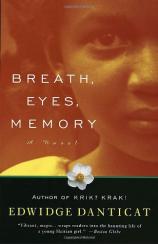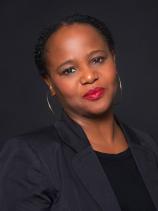Reading Group Guide
Discussion Questions
Breath, Eyes, Memory

1. Edwidge Danticat has said that in Haiti, "Everything is a story. Everything is a metaphor or a proverb." How does the character of grandmother Ifé personify this tendency? How do some of the proverbs and tales she tells Sophie relate to the events and themes of the novel?
2. As a young girl, Martine's favorite color was daffodil yellow; in middle age she is obsessed with the color red. What significance and associations do these colors have for her? In what way does the change from yellow to red symbolize the change in Martine's own character? Does Danticat use color symbolically elsewhere in the story?
3. Martine once hoped to be a doctor; later, she transfers her ambitions to Sophie. "If you make something of yourself in life," she says to her daughter, "we will all succeed. You can raise our heads" (p. 44). Why does Sophie consciously reject her mother's ideal of high achievement? Why does she choose to become a secretary rather than, for instance, a doctor?
4. The character of Atie is perhaps the most complex and mysterious in the novel. Why is Atie so changed when Sophie returns to Haiti? Why does she so resolutely stick to her idea of staying with her mother and doing her "duty," even though Ifé says, "Atie, she should go. She cannot stay out of duty. The things one does, one should do out of love" (p. 119)? What does "chagrin" mean to Atie? What significance does the act of writing in her notebook take on in her life?
5. Atie says to Sophie, "Your mother and I, when we were children we had no control over anything. Not even this body" (p. 20). How does this knowledge help Sophie shape her life? In what ways does Sophie take control of her own life as her mother and aunt never were able to?
6. In the graveyard, Atie reminds Sophie to walk straight, since she is in the presence of family. Grandmother Ifé plans carefully for her death, which she thinks of as a "journey" (p. 195). How does Sophie's grandmother's attitude toward death and the dead, as illustrated in this novel, compare with American ones? How does each culture attempt to foster a sense of wholeness, of continuity, between the generations?
7. Sophie feels that Haitians in America have a bad image as "boat people." Are her efforts to assimilate, to become "American," in any way related to her physical self-loathing ("I hate my body. I am ashamed to show it to anybody, including my husband" [p. 123])? How does her bulimia express such self-loathing?
8. Breath, Eyes, Memory is primarily a story of the relationships between women: mothers, daughters, grandmothers, sisters. But there are two significant male characters in the novel, Joseph and Marc. Does Danticat depict Joseph and Marc as full, rounded-out characters, or do we see them only through Sophie's slanted point of view? How does Sophie express her ambivalent feelings about both of them? Why is she so angry with Marc after her mother's death? Do you feel that her anger is justified? Is it possible that Sophie's aloofness from both these men stems from her upbringing in an almost exclusively female world, where "men were as mysterious to me as white people" (p. 67)?
9. The Haitian goddess Erzulie is both a goddess of love and the Virgin Mary. What does this tell you about the Haitian culture and its ideas of love and religion? How does this differ from American and European culture?
10. Martine's rape by an unknown man, possibly a Macoute, is the defining event in her life, bringing with it overpowering feelings of fear and self-loathing which she passes on to her daughter. Sophie's therapist even suggests that Martine undergo an exorcism. How does Sophie in her own way succeed in "exorcising" the evil events of the past? "It was up to me to avoid my turn in the fire" (p. 203), she says; how does she achieve this?
11. When Sophie breaks her maidenhead with the pestle, she likens it to "breaking manacles, an act of freedom" (p. 130). What exactly does "freedom" mean to Sophie? Which of her other actions represent bids for freedom and autonomy? What does she accomplish when, at the end of the novel, she beats the stalks of sugar cane? What does the final cry of "Ou libéré" (p. 233) mean to Sophie? To Atie? Do you feel that Martine in some manner "liberated" herself by committing suicide? Or was her act one of submission?
12. Do you believe that the three women in the sexual phobia group have comparable problems? Is the word "abuse" equally appropriate in each of their cases? How effective is their joint attempt to free themselves from their past? Is Buki's wrecked balloon a pessimistic symbol? Do you believe that the therapist's psychological tools are adequate to deal with the complex, culturally rooted problems of Sophie and Buki?
13. What is the significance of Martine's "Marassas" story in the context of the relationship between Martine and Sophie? Why does Martine tell the story to Sophie as if she is "testing" her? Why is the theme of likeness, of identification between mother and daughter, so important to Martine? Why does Sophie resist it? When she comes to terms with her mother at the end of the novel, is it because she identifies with her mother or because she comes to feel independent of her? Or both? Do you sense that she has fully forgiven Martine for the hurt she has caused her?
Breath, Eyes, Memory
- Publication Date: January 1, 1998
- Paperback: 234 pages
- Publisher: Vintage
- ISBN-10: 037570504X
- ISBN-13: 9780375705045







